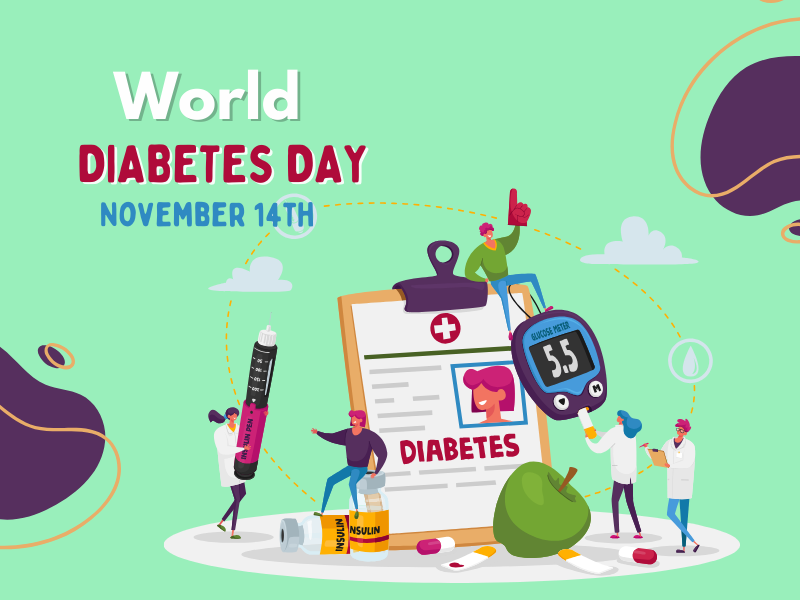Test Parameters: Alanine Amino-transferase (ALT) SGPT
World Diabetes Day: Raising Awareness and Supporting People with Diabetes

World Diabetes Day is celebrated annually on November 14th to raise awareness of diabetes and its effects on people around the world. This blog will discuss what diabetes is, types of diabetes, its symptoms, risk factors, diagnosis, treatment, and treatment.
Type 1 diabetes is an autoimmune disease that causes your body to attack and destroy the insulin-producing cells in the pancreas. Insulin is a hormone that helps your body use glucose for energy. People with type 1 diabetes need to take insulin injections or use an insulin pump to manage their blood sugar levels.
Type 2 diabetes is the most common form of diabetes. It occurs when the body becomes resistant to insulin or doesn't produce enough insulin. Type 2 diabetes can often be managed with lifestyle changes, such as eating a healthy diet, exercising regularly, and losing weight. However, some people with type 2 diabetes may also need to take medication or insulin injections.
Symptoms of diabetes
The symptoms of diabetes can vary depending on the type of diabetes you have. However, some common symptoms of diabetes include:
Increased thirst
Frequent urination
Extreme hunger
Unexplained weight loss
Fatigue
Blurred vision
Slow-healing wounds
Numbness or tingling in the hands or feet
Risk factors for diabetes
The exact cause of type 1 diabetes is unknown, but it is thought to be caused by a combination of genetic and environmental factors. Type 2 diabetes is caused by a combination of genetic and lifestyle factors, including obesity, physical inactivity, and poor diet.
Diagnosis of diabetes
Diabetes is diagnosed with a blood test. The most common blood tests used to diagnose diabetes are:
Fasting blood glucose (FBG) test: This test measures your blood sugar level after fasting for at least 8 hours.
Oral glucose tolerance test (OGTT): This test measures your blood sugar level before and 2 hours after drinking a sugary drink.
Random blood glucose (RBG) test: This test measures your blood sugar level at any time of day, regardless of when you last ate or drank.
Treatment for diabetes
The goal of diabetes management is to keep blood sugar levels within a healthy range. This can be done through a combination of lifestyle changes, medication, and insulin injections.
Lifestyle changes: Lifestyle changes that can help to manage diabetes include eating a healthy diet, exercising regularly, and maintaining a healthy weight.
Medication: There are a number of different medications that can be used to treat diabetes, depending on the type of diabetes you have and your individual needs. Some diabetes medications help to lower blood sugar levels by increasing the body's production of insulin or by making the body's cells more sensitive to insulin. Other diabetes medications help to prevent the body from absorbing too much sugar from food.
Insulin injections: People with type 1 diabetes need to take insulin injections or use an insulin pump to manage their blood sugar levels. Insulin injections are also sometimes used to treat type 2 diabetes.
- The Gut-Brain Connection: Unlocking the Secret to Holistic Health for Indians
- Why Regular Health Check-ups are Crucial for Every Indian
- Understanding Common Blood Tests: What Your Results Mean
- The Importance of Regular Health Screening: Top Tests You Shouldn't Skip
- Vitamin D: A Nutrient with Far-Reaching Benefits
- National Health Checkup Day: Your Path to a Healthier You
- International Day for Endurance: Celebrating the Power of Perseverance
- Understanding and Conquering Arthritis: World Arthritis Day
- World Mental Health Day: It's Okay To Not Be Okay
- Beyond Mosquito Bites: The Fight Against Dengue and Malaria
- The Importance of Preventive Health Screenings.
- Keep Your Kidneys Healthy: Test Before They Test You
- The Best Pathology Lab in Panvel, Navi Mumbai, Seawoods
- Full Complete Body Checkup in Panvel, Navi Mumbai, Seawoods
- Blood Test Collection Labs in Panvel, Navi Mumbai, Seawoods
- Best Diagnostic Centre in Panvel, Navi Mumbai, Seawoods
- The role of Pathology Lab in disease diagnosis
- Save Time and Money with an At-Home Body Checkup
- Importance of early detection and full body checkup
- Exploring the Importance of Lipid Testing Alongside ECG for Assessing Heart Health
- Reliable home blood sample collection
- Full Body Checkup Session In Navi Mumbai
- Free Home Blood Sample Collection in Navi Mumbai
- Best Online Pathology Lab
- Best Diagnostic Center
- Affordable Online Full Body Checkup Packages

